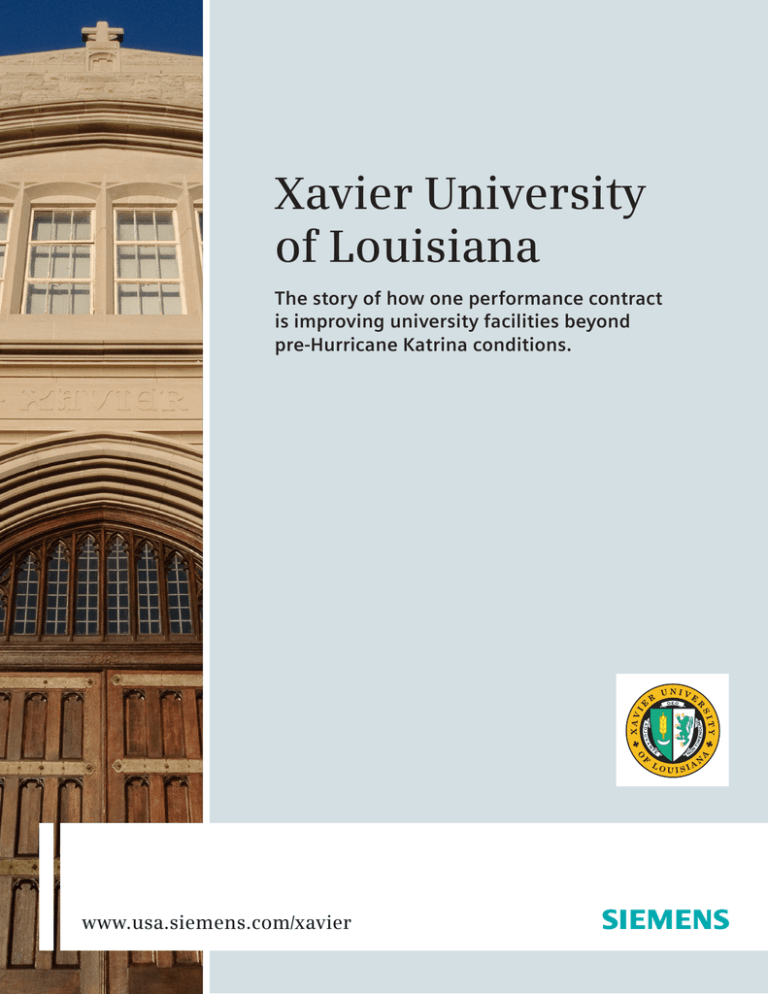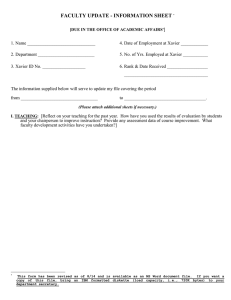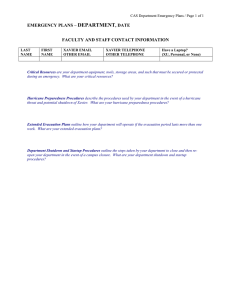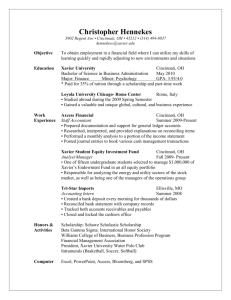
Xavier University
of Louisiana
The story of how one performance contract
is improving university facilities beyond
pre-Hurricane Katrina conditions.
www.usa.siemens.com/xavier
s
Equipment upgrades were needed and facility
improvement projects were discussed. Then Hurricane
Katrina hit and New Orleans-based Xavier University
of Louisiana’s needs suddenly grew exponentially.
Originally founded by Saint Katharine Drexel and the
Sisters of the Blessed Sacrament in 1915 as a high
school, Xavier University is a private institution and the
country’s only Catholic Historically Black College and
University (HBCU). In 1925, a four-year college program
was established and when the sisters transferred control
over to a board of trustees in 1968, Dr. Norman C. Francis
became president; he is still president today and is the
longest tenured college president in the United States.
Almost 75 percent of Xavier University’s 3,399 students
are African American, although anyone is welcome to
attend. The university offers preparation in 47 major
areas at the undergraduate, graduate and professional
degree levels.
Learning happens on the campus’ 27 acres in
approximately 20 buildings, totaling more than 3 million
square feet of space. The university has a rich history,
which its facilities reflect. The oldest campus buildings
were built in the 1930s; the university’s newest buildings
are presently under constrction. The campus is
constantly growing and renovation is ongoing.
Performance Contracting Defined
Performance contracting is a means of financing a multifaceted capital improvement project. An energy services
company (ESCO) identifies facility improvement measures
(FIMs) that will reduce water, sewage, electricity, steam,
natural gas, etc. and guarantees the predicted savings.
The ESCO provides single-source accountability, acting as
project manager, executing the work and/or hiring local
contractors.
The contractee gets a loan to pay for the improvements.
The cost of the project is divided by the guaranteed annual
savings to determine the length of the contract. Project
payment is based on the guaranteed annual savings.
Once the project is implemented, the savings resulting
from increased efficiencies are used to make loan payments
to the capital leasing company. If the actual savings are in
excess of the guaranteed savings, the contractee keeps the
amount above the guarantee. If they are lower, the ESCO must
pay the contractee the difference. Beyond the term of the
contract, the contractee receives the entire energy savings.
In August 2005, when Hurricane Katrina hit the gulf coast,
toxic flood waters inundated Xavier University. Every
building but one – the Sisters of the Blessed Sacrament
convent – sustained massive damage. Because New
Orleans’ levees were breached, the university had 12
feet of water on campus. Estimated construction-related
damages from the flooding and high winds exceeded
$75 million.
Xavier University was forced to close its doors for the
fall 2005 semester. “Hurricane Katrina caused us to
close our facilities for a number of months,” says Marion
Bracy, Vice President, Facilities Planning & Management,
Xavier University. The university reopened its doors in
January 2006.
Aside from the immediately recognizable destruction
and disrepair, the school is still discovering latent damage,
such as pipes rusting out, and dealing with government
and insurance agencies more than six years later. As a
result of Hurricane Katrina, however, maintenance that
had been deferred for years was addressed and the
university began thinking more seriously about increasing
operating efficiency.
To truly reduce the campus’ energy consumption and bring
old systems up to date, the university would turn to its
long-time trusted partner, the Building Technologies
division of Siemens Industry, Inc.
How Performance Contracting Works
Savings
Project
Payment
Utility
Bill
Before
Performance
Contract
Utility
Bill
During
Performance
Contract
Utility
Savings
Savings
Utility
Bill
After
Performance
Contract
Conditions on Campus
By 2008, Xavier University was ready to explore ways to
improve its campus and address problems from Hurricane
Katrina that remained unresolved. Many of the buildings
had aging infrastructure that was inefficient, unreliable
and operationally intensive. “We were utilizing a lot more
energy than we should have been,” says Bracy of the
institution’s $2.5 million average annual electric bill. “
We could not control the air quality in a number of
buildings and were wasting a high level of water. Our
lighting, although we were making some improvements,
was a patchwork. We were also overworking our
electrical system. We knew that we needed to do
something, we just needed some guidance.”
The university faced rising energy costs, growth and
minor budget cuts. “The cost of operating was climbing
constantly, and as we grew, we saw that our utility
usage was rising. We had to find a way to maintain
our standard of living and stay within budget,”
explains Sheppard Roubion, Director of Building
Services, Xavier University.
Improvements that addressed deferred maintenance and
inefficient equipment weren’t the only facility projects
desperately needed at Xavier University. The capacity
of the chilled water plant was a problem after Hurricane
Katrina. The hurricane caused damage to two chillers,
leaving just one that remained functional. The university
was in a vulnerable position, having no redundancy.
The one operational chiller was being taxed to deliver
enough water to meet all of the campus’ needs. The
university knew it had a pumping and control issue
with its chilled water and needed a solution.
Additionally, some facilities were simply unable to
provide an environment conducive to learning or the
conditions demanded by staff and students. “We wanted
to improve customer comfort and know that the person
in room 15 was just as comfortable as the person in
room one,” says Bracy.
Performance Contracting
To complete an extensive facility improvement program,
the university decided to enter into a performance
contract by partnering with an energy services company
(ESCO). This would be the first performance contract in
Xavier University’s more than 90-year history.
Performance contracting was advantageous for a number
of reasons. First and foremost, the university could get a
large volume of work done all at once, instead of making
the improvements over many years as part of a long-term
capital improvement program. And Xavier University could
begin reaping the energy savings immediately. “We’ve
been in on conversations and meetings with people about
energy-saving concepts … and we’ve done a lot in-house,”
says Bracy. “But this performance contract has really
allowed us the opportunity to do a massive project.”
Hiring an ESCO freed the university from the laborintensive project management duties required for an
improvement program of this magnitude. While the
university’s facilities team concentrated skills, effort and
time on several capital construction projects, a trusted
ESCO would be diligently completing numerous other
facility improvement measures on campus.
Xavier University was contemplating a performance
contract when Katrina hit, but immediately afterwards, the
university had to focus solely on its recovery. “Right after
Katrina, we just had to put everything on hold,” says Bracy.
Insurance and federal aid only provided funding to restore
facilities to the condition they were in before the event.
“An upgrade was no longer an option,” he adds.
Three years after Hurricane Katrina, the university
was serious about and ready to explore performance
contracting. “It was all about timing for us. We had the
opportunity and funding to move forward and we took
advantage of it,” says Bracy. “We had just come out of
one of the biggest renovations in the history of the campus
after Hurricane Katrina. We wanted to save money, but we
also wanted to make sure that the savings would continue
to work for us.”
Selecting an ESCO
Before issuing an RFP for an energy performance contract,
the facilities professionals at Xavier University sought
advice from trusted industry sources. Three years ago,
leaders of the facilities team began asking lots of questions
to vendors, end users, fellow members of various industry
associations and peers they met at national trade shows.
“We’d talk to them and ask, ‘what are you doing, what are
you doing right, what have you done wrong and what are
your experiences?’ That’s one of the great parts about
establishing those relationships,” says Bracy. “They can
be truthful with us because they don’t have any vested
interest in us doing it or not doing it.”
They asked peers in Kentucky, Arizona, Tennessee and
Georgia about their experiences, hoping to apply the same
best practices and avoid otherwise unknown pitfalls. From
these conversations, the university developed key criteria
from which to evaluate ESCOs. More importantly, they
recognized the need to partner with a company they
could trust and professionals that would be there to
answer questions during and after the projects were
implemented.
Approximately 70 occupancy sensors were installed under the
performance contract, which will discontinue the practice of
lighting unused rooms. “It’s not enough just to say a person’s
going to walk out of a room and turn off a light, so we had
sensors put in some of those rooms,” says Bracy.
As a result, when the RFP was issued and ESCOs
responded, they were judged not only on the bottom-line
savings guaranteed, but also on reputation and which
company’s capabilities would best fit the university’s
needs. Based on the knowledge they had gathered,
criteria they set and past experiences, Xavier University
selected Siemens.
Lighting in 21 facilities has been improved by upgrading
old inefficient technology to energy-saving lamps, fixtures
and ballasts. Savings from the lighting projects alone are
estimated to reduce Xavier University’s annual kilowatthours by approximately 1,271,989.
The school has been a Siemens customer since 1980 and
after 30 years of working together, a solid relationship
and foundation of trust has been built. “Siemens
established a good reputation on campus,” says Bracy.
In March 2010, Xavier University signed a 10-year, $4.3
million performance contract.
The Projects
Siemens’ energy engineers performed an investmentgrade energy audit of the campus facilities and
generated a list of approximately 40 different facility
improvement measures (FIMs) for Xavier University’s
review. Payback for these FIMs ranged from two to 50
years. With this list in hand, Siemens sat down with the
university’s facilities team to review the benefits and cost
of each potential project. From this list, Xavier University
chose five types of projects, which would make up the
performance contract.
Lighting Upgrades
Not only was the lighting equipment in many of Xavier
University’s buildings inefficient, but its operation was
just as wasteful. “Before this project started, you could
drive by campus at night and it looked like a Christmas
tree with so many different office and area lights on.
Now that we have installed occupancy sensors, there’s a
vast improvement,” says Roubion. “And that’s a large
reduction in energy use.”
Chilled Water System Optimization
With just one chiller functional after Hurricane Katrina hit,
the university turned to Siemens to optimize the 2,400-ton
capacity of its central chilled water plant, which serves over
14 buildings on campus.
At the cornerstone of Xavier University’s facility improvement
program was Demand Flow™, a proven Siemens patentpending technology that optimizes central chilled water
systems to reduce the plant’s total energy consumption by
20 to 50 percent. This chiller plant optimization solution
increases the deliverable tonnage of the chilled water plant
and simplifies operations, without sacrificing occupant
comfort. Demand Flow will cut Xavier University’s annual
energy consumption by 2,299,447 kWh annually.
Physical upgrades, repairs and additional mechanical
installations have been implemented, including new
variable frequency drives (VFDs) on all chilled water
pumps, chilled water temperature and flow sensors in
multiple buildings and two-way chilled water control
valves on air-handling units.
Energy Management and Control Systems
To increase energy efficiency and give Xavier University
greater control over building systems, Siemens enhanced
the APOGEE® Building Automation System to perform
the time-of-day scheduling function. Time of day (TOD)
scheduling allows the building automation system to start
and stop HVAC equipment at a specific time, instead of
letting it run 24 hours.
Impact of Facility Improvement Measures
Lighting Upgrades
Chilled Water
Optimization
Mechanical System
Improvements
Water Conservation
21 facilities
20–50% reduction
314,604 kWh
16,000 therms
provided lighting
improvements
in central plant energy
consumption
of annual electricity savings
in reduction of
domestic hot water
1,271,989 kWh
2,299,447 kWh
in estimated annual
gas savings
of annual energy savings
of annual energy savings
437 ccf
16% reduction
in annual water usage
Enhancements to the system have also enabled Xavier
University to implement Demand Control Ventilation
(DCV). Whenever possible, the systems in these buildings
now provide functional control of air-handling units
in order to provide an optimal level of outside air
ventilation based upon room occupancy. “Being in the
deep south, we have a serious heat and humidity issue.
Demand ventilation will actually provide a more healthy
environment for the occupants based on CO2 discharge,”
explains Roubion.
reduce flow, yet still provide the necessary service needed
to wash hands. In some areas, pedal valves (e.g., kitchen
areas) were installed on wash sinks.
Implementation of TOD scheduling and DCV has taken
place in a total of 15 facilities on campus. Xavier
University’s existing system has been upgraded with
the latest Siemens APOGEE Insight and training is being
provided to ensure proficient operation of the system
by the staff at the university.
“Many of these are things that we had on our list to do
but just didn’t have the funds to do,” says Bracy. The
performance contract provided both the opportunity
and the financing means to address known and unknown
inefficiencies and problems.
Mechanical System Improvements
Multiple improvements have been made to Xavier
University’s mechanical systems in an effort to streamline
operations and reduce dependency on utilities. Siemens
has re-insulated sections of chilled water, dual temperature
and heating hot water piping where insulation was missing
or badly damaged. The repair or replacement of worn out
or damaged piping insulation has improved operating
efficiency. “The piping insulation projects worked out
well for us,” explains Bracy. The mechanical pipe insulation
improvements will save the university an estimated
314,604 kWh of electricity and 437 ccf in estimated
gas savings each year. Piping insulation repair took
place in 14 buildings.
Six new motorized valves have been added to the dualtemperature piping entrance near three buildings (i.e.,
the Gymnasium, Katharine Drexel Residence Hall and St.
Michael’s Residence Hall) to automatically isolate the
building piping from the central energy plant during
heating-cooling switchover. “That’s going to help us with
a few of the older buildings, where there is what’s called
a two-pipe system. Otherwise, we have to physically
switch those over between times of year that require
cooling and heating,” says Roubion.
Air distribution modifications, including the addition of
variable speed drives on electric motors, have been made
to existing ductwork, distribution boxes and grilles to
optimize energy efficiency and occupant comfort in the
College of Pharmacy.
Water Conservation
Water conservation projects included replacing wallmounted and floor-mounted toilets with low-water usage
devices and installing aerators on lavatory faucets to
Siemens has installed either water use or cost-reduction
devices and/or new plumbing fixtures in 26 facilities to
reduce the more than 22 million gallons of water used
annually by the institution to 18.4 million gallons per year.
Additionally, the BTUs of annual domestic hot water will
be reduced from 1,645 MMBTUs (about 16,000 therms).
Construction
“We had agreements to sign contracts and they actually
asked us to get started over the holidays while the kids
were away from campus,” says John Agnelly, account
executive, Siemens. “So we started part of the project
on just a handshake.” With the lighting retrofit already
partially completed, the construction formally began in
March 2010 and was completed over the following 12
months. Siemens either performed the work using its
technicians and engineers, or acted as general contractor
and hired local subcontractors who implemented the FIMs.
Executing some of the projects proved challenging.
Several of the campus’ older buildings required work
to be performed in such a way to preserve the historic
integrity of the facilities. During a construction project in
an older building, especially historic buildings, to make
discoveries not previously uncovered in a preliminary study
is common; such was the case at Xavier University. “Over
the years, as the old buildings were modified, some things
were left by the wayside and then it was rediscovered and
put back into service,” says Roubion of some surprising
HVAC discoveries.
Additionally, finding time to complete the work when it
would cause minimal disruption was critical. “On a college
campus, scheduling is always a problem,” says Bracy. The
work had to be performed in as least disruptive a means
as possible. “There are a number of people around campus
right now that cannot tell you how much we’ve actually
done because [Siemens has] worked nights, weekends
and off-times,” he says. “Our customers are going along
with their day-to-day activities not knowing that we have
a major undertaking that’s happening right underneath
them. To me, that’s worth its weight in gold.”
As soon as construction was completed, the measurement
and verification phase began. Some of the savings (e.g.
lighting) will be verified using pre- and post-measurement
data. However, the chilled water savings validation is
based on continuous dynamic measurement. Siemens
monitored all of Xavier University’s chillers and pumps to
establish how much energy they were previously using to
deliver chilled water, and is now determining how much
chilled water tonnage is currently being delivered; a daily
calculation will be applied to show the ton-hours used
and how efficiently they are being delivered.
Previously, Xavier University had only one meter for the
entire campus. “The problem that we’ve had,” explains
Bracy, “is that as we’re doing some improvement, there
was no way, other than looking at a monthly bill, of
actually measuring the savings. Now we have meters
around so we have the ability to measure it a lot better.”
Whereas Xavier University didn’t have a precise way to
validate the savings resulting from its previous projects,
this performance contract has now provided greater
measurement capabilities.
“The lighting contractor measured all the lighting at
the desk level to make sure it’s meeting the lighting
standards and guidelines for classroom environments,”
says Agnelly.
Healthier indoor air quality and improved lighting make
a noticeable difference. “Our main goal is to provide
education to young people. If the environment is
uncomfortable, it distracts them from learning,” says
Roubion. “The goal is to give them a safe, healthy,
comfortable environment so they can concentrate
on making the grade.”
The facility improvement projects also demonstrate
Xavier University’s commitment to the environment.
“A number of younger people as they come into the
university were asking, ‘what are we doing to conserve
energy and better utilize whatever energy sources we
have coming into the campus?’” says Bracy. “Even their
concern created an awareness.”
The Benefits
The work performed under the performance contract
will dramatically cut the university’s utility expenses.
“Ultimately, we wanted to be known as an energyefficient campus,” says Bracy. Thanks to the projects
completed under this agreement, Xavier University has
achieved that status. Siemens is guaranteeing annual
savings of $553,213, of which $472,516 is due to the
reduction in energy use. “Now we’re not just saying that
we’re saving money, but we can show people how we’re
saving it and how we’ve been utilizing energy,” says Bracy.
Not only will the university use less energy, but it will
be easier and less costly for in-house staff to maintain
campus buildings. New occupancy sensors mean that
people will no longer have to turn lights off manually
and because lamps won’t be running as long, relamping
will not be as frequent, saving money and staff time.
Standardizing on lamps and other fixtures will also
keep costs down.
Improved control and operation of HVAC equipment
has already proven beneficial. “The number of hot/
cold calls has already gone down drastically,” noted
Bracy soon after the project’s completion. Additionally,
remote monitoring and control of building systems will
prevent technicians from performing manual onsite
operations, freeing up their time to do more valuable
tasks. Operations and maintenance-related savings, not
all of which are included in Siemens’ guarantee, total
$150,000 per year.
Students, staff, faculty and visitors are more comfortable
in campus facilities now. Demand ventilation will
ensure that the required amount of outdoor air is being
brought into buildings and that CO2 levels are maintained
properly. Lighting is easier on the eyes now too.
Environmental Impact of Campus Improvements
130 acres
3,385 cars
of trees preserved
from deforestation
removed from the road
for one year
By executing these FIMs, Xavier University, over the
full term of the performance contract, will reduce the
amount of CO2 emissions (the result of saving electricity
and natural gas) equivalent to:
• 130 acres of forest preserved from deforestation.
• 97 railcars of coal not burned.
• 3,385 cars removed from the road for a year.
Other emissions are being cut as well. Nitrogen oxide
(NOx) emissions will be reduced by 6,695 pounds
annually and the sulfur dioxide (SO2) emissions
reduction totals 6,896 pounds each year.
The performance contract between Siemens and Xavier
University has been a resounding success. Facilities
are easier to operate, more efficient and provide a
better learning environment for students. Construction
happened with minimal inconvenience and disruption.
“Siemens’ workers were very polite, very efficient, and
everything went as well as we expected,” says Roubion.
“This was a well-run project.”
Replace magenta box with
appropriate FSC logo and
language. Please fit logo
within dimensions of the
magenta box - aligning FSC
logo to the bottom of the
box first.
Siemens Industry, Inc.
Building Technologies Division
1000 Deerfield Parkway
Buffalo Grove, IL 60089
Tel: (847) 215-1000
Fax: (847) 215-1093
Copyright 2011
Siemens Industry, Inc.
All rights reserved.
(4/12)
www.usa.siemens.com/xavier






